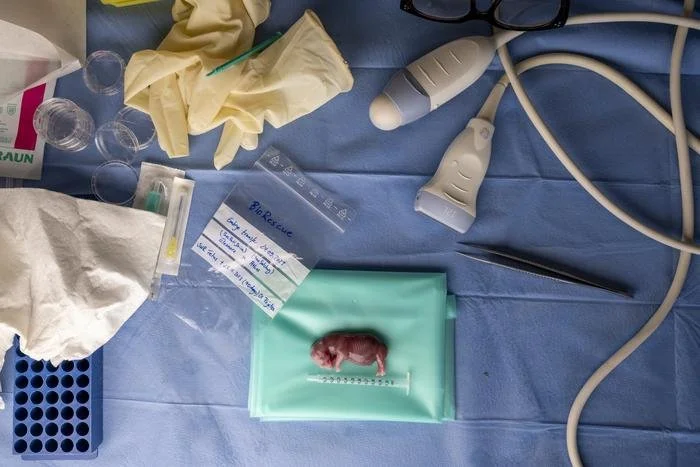Two northern white rhinos are left on Earth. A new breakthrough offers hope from extinction
On September 24, 2023, the BioRescue scientists and veterinarians, led by the Leibniz Institute for Zoo and Wildlife Research (Leibniz-IZW), transferred two southern white rhino embryos into Curra, a southern white rhinoceros, selected as a surrogate mother at the Ol Pejeta Conservancy in Kenya. The oocytes used in producing the embryos were retrieved from Elenore, a southern white rhinoceros living in the Pairi Daiza Zoo in Belgium. The sperm used for fertilisation originated from the male Athos from the Zoo Salzburg in Hellbrunn, Austria. The oocytes from Elenore were fertilised in vitro by intracytoplasmic sperm injection (ICSI) and developed into blastoscysts at Avantea‘s laboratories in Cremona, Italy. For the embryo transfer in Kenya, the BioRescue scientists transferred two embryos to increase the chance of a successful outcome.
So far, the BioRescue team has performed 13 embryo transfers in rhinoceroses, three in Kenya and ten in Europe. Previously, an embryo transfer, which is a widely used technique in domestic species, has never been attempted in rhinos. BioRescue scientists developed the necessary techniques, by building on decades of their own research.
Currently, there are only two northern white rhinos left in the world: The female Najin and her daughter Fatu. Additionally, living cells from 12 different northern white rhino individuals are stored in liquid nitrogen. The last two females currently live in Kenya, at Ol Pejeta Conservancy, where they are guarded and cared for day and night. Since 2019, the BioRescue conservation science programme produced and cryopreserved 30 northern white rhino embryos. These are currently stored in liquid nitrogen at minus 196 degrees Celsius in Berlin, Germany, and Cremona, Italy, awaiting embryo transfer into southern white rhino surrogate mothers. The successful transfer of a southern white rhino embryo is a proof of concept that allows to take this crucial step – an embryo transfer with a northern white rhino embryo – for the first time.
The embryo transfer in this subspecies is entirely new ground as a veterinary and scientific procedure, and all protocols, methods and pieces of equipment had to be newly developed from scratch. As it is the established routine with all BioRescue procedures, the embryo transfers are accompanied by an ethical assessment conducted by Padua University. This was also the case in September, when all participants of the embryo transfer filled out a questionnaire that proposed any possible scenarios during the procedure, and attendant risks to animals and participants.
The vasectomised, sterile teaser bull Ouwan mated with Curra on September 17 and 18, signalling the ideal timing for the embryo transfer, which took place on September 24. After the procedure until November 2023, Curra was monitored on a daily basis in the enclosure at the Ol Pejeta Conservancy. During this period, Ouwan showed no further interest in Curra, a first sign of a successful embryo transfer resulting in pregnancy. The BioRescue team was scheduled for November 28 to perform a pregnancy check in Curra, but the teaser bull Ouwan was found dead on November 22 and Curra was found dead on November 25. Apparently, extremely heavy rains led to a flooding of the surrogate enclosure and set free dormant clostridian bacteria spores. The dissection of the animals revealed a severe systemic infection by a clostridian bacterial strain and resultant intoxication by the bacterial toxin. It also revealed that Curra was pregnant with a 70 days old male foetus that was 6.4 cm long. Tissue samples of the foetus were collected and transported to the Max Delbrück Centre for Molecular Medicine and the Leibniz-IZW in Berlin, Germany. In January 2024, it was confirmed through the analysis of the foetus DNA that the pregnancy resulted from the embryo transfer.
When the BioRescue team arrived in Kenya on November 28, the preliminary results indicated an intoxication with the clostridian bacterial strains Paraclostridium bifermentansand Paenicolostridium sordellii. Immediately after the incident, the BioRescue team, including Kenya Wildlife Service, Wildlife Training Research Institute, Ol Pejeta Conservancy and Safari Park Dvůr Králové formed a crisis team on site and established fast and effective measures to protect all current semi-captive rhinos including the last two northern white rhinos Najin and Fatu. The measures included a vaccination programme, quarantine of affected areas and fencing of new emergency enclosures.
The next steps in the BioRescue research programme included the selection and preparation of a new teaser bull. The bull will allow the scientists to know when a possible surrogate female is ready to receive an embryo implantation. The team also has to select the next surrogate mothers. After these steps, which will take several months, an embryo transfer with a northern white rhino embryo will be attempted.
The BioRescue research programme is supported by the German Federal Ministry of Education and Research (BMBF) over a time-period of six years with up to around 6 million Euros.



